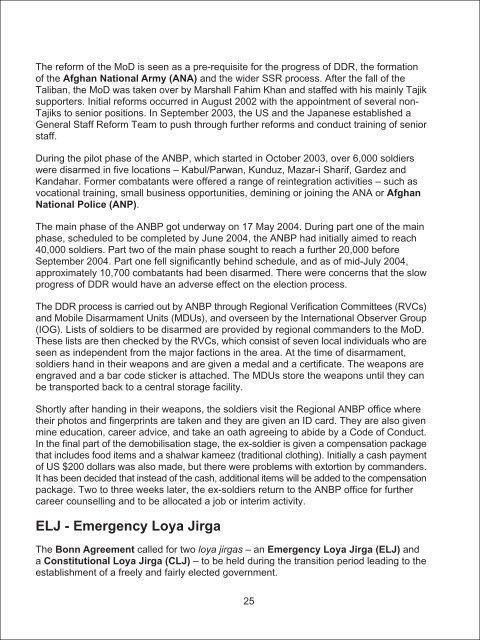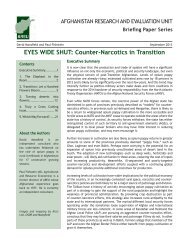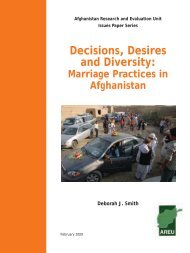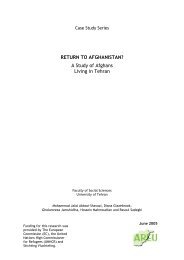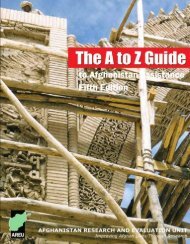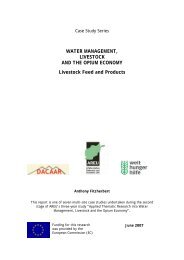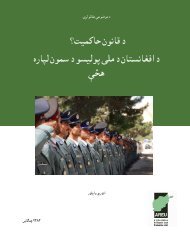A to Z Guide to Afghanistan Assistance Third Edition
A to Z Guide to Afghanistan Assistance Third Edition
A to Z Guide to Afghanistan Assistance Third Edition
You also want an ePaper? Increase the reach of your titles
YUMPU automatically turns print PDFs into web optimized ePapers that Google loves.
The reform of the MoD is seen as a pre-requisite for the progress of DDR, the formation<br />
of the Afghan National Army (ANA) and the wider SSR process. After the fall of the<br />
Taliban, the MoD was taken over by Marshall Fahim Khan and staffed with his mainly Tajik<br />
supporters. Initial reforms occurred in August 2002 with the appointment of several non-<br />
Tajiks <strong>to</strong> senior positions. In September 2003, the US and the Japanese established a<br />
General Staff Reform Team <strong>to</strong> push through further reforms and conduct training of senior<br />
staff.<br />
During the pilot phase of the ANBP, which started in Oc<strong>to</strong>ber 2003, over 6,000 soldiers<br />
were disarmed in five locations – Kabul/Parwan, Kunduz, Mazar-i Sharif, Gardez and<br />
Kandahar. Former combatants were offered a range of reintegration activities – such as<br />
vocational training, small business opportunities, demining or joining the ANA or Afghan<br />
National Police (ANP).<br />
The main phase of the ANBP got underway on 17 May 2004. During part one of the main<br />
phase, scheduled <strong>to</strong> be completed by June 2004, the ANBP had initially aimed <strong>to</strong> reach<br />
40,000 soldiers. Part two of the main phase sought <strong>to</strong> reach a further 20,000 before<br />
September 2004. Part one fell significantly behind schedule, and as of mid-July 2004,<br />
approximately 10,700 combatants had been disarmed. There were concerns that the slow<br />
progress of DDR would have an adverse effect on the election process.<br />
The DDR process is carried out by ANBP through Regional Verification Committees (RVCs)<br />
and Mobile Disarmament Units (MDUs), and overseen by the International Observer Group<br />
(IOG). Lists of soldiers <strong>to</strong> be disarmed are provided by regional commanders <strong>to</strong> the MoD.<br />
These lists are then checked by the RVCs, which consist of seven local individuals who are<br />
seen as independent from the major factions in the area. At the time of disarmament,<br />
soldiers hand in their weapons and are given a medal and a certificate. The weapons are<br />
engraved and a bar code sticker is attached. The MDUs s<strong>to</strong>re the weapons until they can<br />
be transported back <strong>to</strong> a central s<strong>to</strong>rage facility.<br />
Shortly after handing in their weapons, the soldiers visit the Regional ANBP office where<br />
their pho<strong>to</strong>s and fingerprints are taken and they are given an ID card. They are also given<br />
mine education, career advice, and take an oath agreeing <strong>to</strong> abide by a Code of Conduct.<br />
In the final part of the demobilisation stage, the ex-soldier is given a compensation package<br />
that includes food items and a shalwar kameez (traditional clothing). Initially a cash payment<br />
of US $200 dollars was also made, but there were problems with ex<strong>to</strong>rtion by commanders.<br />
It has been decided that instead of the cash, additional items will be added <strong>to</strong> the compensation<br />
package. Two <strong>to</strong> three weeks later, the ex-soldiers return <strong>to</strong> the ANBP office for further<br />
career counselling and <strong>to</strong> be allocated a job or interim activity.<br />
ELJ - Emergency Loya Jirga<br />
The Bonn Agreement called for two loya jirgas – an Emergency Loya Jirga (ELJ) and<br />
a Constitutional Loya Jirga (CLJ) – <strong>to</strong> be held during the transition period leading <strong>to</strong> the<br />
establishment of a freely and fairly elected government.<br />
25


